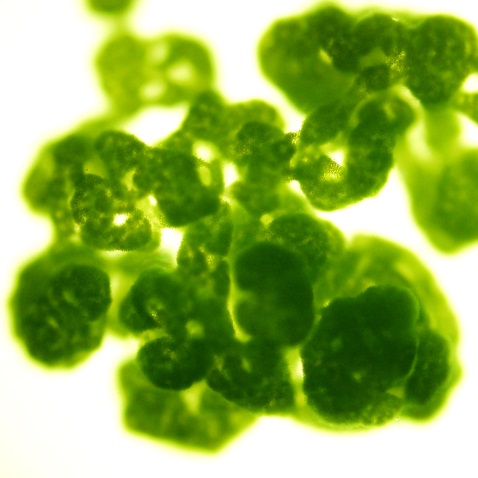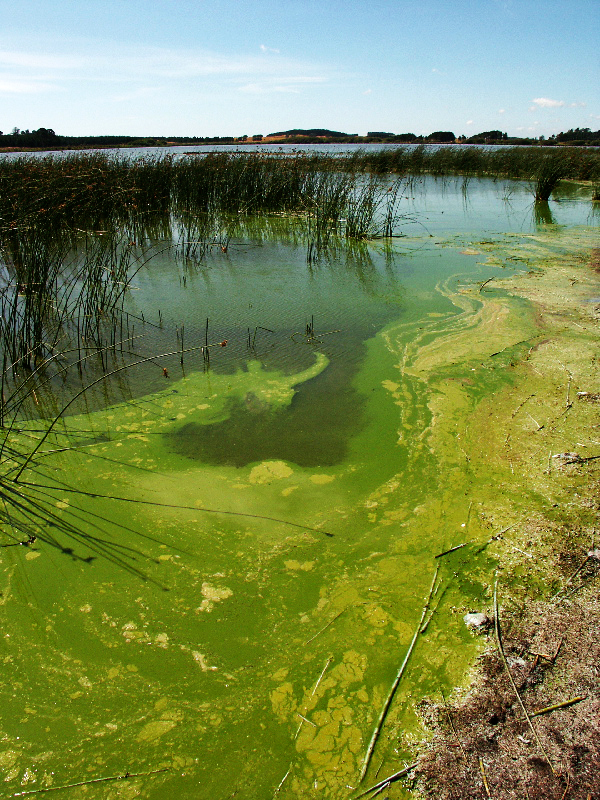What are algae?
Algae are plant-like aquatic organisms, many of which are single-celled, but others grow in mats or filaments. Algae are the basis of most aquatic food webs, they produce oxygen to the atmosphere, absorb nutrients and can be a good indicator of water quality.
Why can algae become a problem?
High concentrations of algae can have negative effects on water quality and appearance.
Large amounts of algae in lakes (called an algal bloom) can:
- decrease the clarity of the water
- change the colour of the water (making it greener)
- reduce dissolved oxygen when they sink and decompose
- alter the pH of the water
- produce unpleasant tastes and smells
- impact other organisms living in the water
- cause public health concerns: cyanobacteria (also known as blue-green algae) can produce toxins that can cause illness in humans and animals.
How are algae measured?
The amount of algae in the water is determined by measuring chlorophyll α, the green pigment in plants and algae that is used for photosynthesis. Measuring how much of this pigment is in the water provides a good indicator of the total amount (or biomass) of algae in a lake. Algae are important for the lake ecosystem. However, when their abundance is too high they can become a problem and contribute to poorer water quality.
Algae (phytoplankton) and trophic state
Algae that live in the water column of lakes are also known as phytoplankton. The amount of phytoplankton in a lake is often closely linked with the amount of nutrient enrichment and biological productivity of a lake ecosystem (trophic state). Thus phytoplankton (measured as chlorophyll a) is included as an attribute in the NPS-FM 2020, with bands for both annual median (as a measure of general lake health) and annual maximum (as a measure for the occurrence of large blooms). Lakes with high levels of phytoplankton, that are in excess of the national bottom line, are lakes which have undergone (or are at risk to undergo) regime shifts to a persistent, degraded state in which native aquatic plants are absent.
What are cyanobacteria?
Cyanobacteria (or blue-green algae) are microscopic organisms that play a very important role in many land and aquatic ecosystems. Cyanobacteria are naturally occurring and live in a range of waterways, from near-pristine to those more impacted by land-use. Technically speaking cyanobacteria are bacteria, not algae (which are more similar to plants), but they perform the same ecological function of converting sunlight into energy and oxygen (via photosynthesis). Hence, they are often grouped with algae. Some cyanobacteria can produce toxins (commonly known as toxic algae) that are harmful to animals and humans. In aquatic environments, cyanobacteria can multiply and form blooms, which can be suspended in the water column (planktonic) or attached to rocks (benthic).

A colony of Microcystis made up from many thousands of cells.
In lakes and slow-flowing waters, cyanobacteria grow in the water column (planktonic) which can cause the water to become murky or cloudy. Planktonic cyanobacterial blooms are generally bright green in colour and can give lakes a ‘pea soup’ appearance. They can also form visible green to red films or scums on the water’s surface, especially at the water’s edge.

A planktonic cyanobacteria bloom in Lake Horowhenua.
Why can cyanobacteria become a problem?
When cyanobacteria are present at low levels they don't impact ecosystem health or present a health risk to people and animals. However, they can become a problem when they increase to high concentrations, forming 'blooms'. Blooms are more common during the summer months, when low rainfall, warm temperatures, the right level of nutrients and more sunlight create an environment where it can thrive. But blooms can happen all year round, whenever the right conditions occur. Winter blooms have been documented in lakes in Aotearoa since the 1970/80s (Pridmore & Etheredge 1987). Cyanobacteria blooms are expected to increase with rising temperatures (Puddick et al., 2022).
Other than the general effects of algal blooms on waterways (e.g. reduction in light in the water column, and reduction in oxygen upon decomposition), cyanobacteria are known to produce toxins. These natural toxins, known as cyanotoxins, can be a threat to humans and animals when ingested (eaten, even licked, or when water containing the toxins is swallowed), inhaled or through contact with skin. The toxin levels can only be determined by laboratory testing. Under what conditions toxins are produced is not well understood, and actual toxin levels in the water are highly variable even over short time periods. Therefore, we have adopted a conservative risk-based approach that assumes that toxins are present at all times in all blooms of cyanobacteria species that are known toxin producers. More information on the effects to people and animals from these potentially toxic algae can be found in this factsheet.
How are cyanobacteria measured?
Planktonic cyanobacteria are assessed by collecting a sample of water from the lake, identifying what species of cyanobacteria are present, and counting the number of cyanobacterial cells present. Cell counts and sizes are used to estimate a biovolume of total cyanobacteria and of potentially toxic cyanobacteria. Because in many instances, larger cells can produce more toxins than smaller cells, biovolume provides a better estimate of potential risk than simple cell counts.
Water quality samples for long-term State of the Environment (SOE) monitoring programmes are usually collected from representative mid-lake locations. The biovolumes of cyanobacteria in these samples are evaluated nationwide against attribute bands described in the NPS-FM 2020, resulting in grades from A (good) to D (poor). At least 12 samples over a 3-year period are used to assess the current state of the lakes for cyanobacteria. See the factsheet on how LAWA calculates state in lakes.
Planktonic cyanobacteria cell counts and biovolumes are also assessed against swimming suitability using the New Zealand interim guidelines for cyanobacteria in fresh waters. See the factsheet about how the guidelines are used for the Can I swim here? topic. Water quality samples to inform swimming suitability are generally collected over the summer months from the lake shore, in areas where people are most likely to be swimming.
Where to get further information?
- Department of Conservation information on native algae.
- Landcare Research resource on freshwater algae identification
- New Zealand guidelines for cyanobacteria in recreational fresh waters: Interim guidelines
- Pridmore, R. D., & Etheredge, M. K. (1987). Planktonic cyanobacteria in New Zealand inland waters: Distribution and population dynamics. New Zealand Journal of Marine and Freshwater Research, 21(3), 491–502. https://doi.org/10.1080/00288330.1987.9516245
- Puddick J, Kelly LT, Wood SA 2022. Climate change and toxic freshwater cyanobacteria in Aotearoa New Zealand. Prepared for New Zealand Ministry of Health. Cawthron Report No. 3765. 65 p. Environmental Health Report: Climate change and toxic freshwater cyanobacteria in Aotearoa NZ (esr.cri.nz)
- USGS Field and laboratory guide to freshwater cyanobacteria harmful algal blooms
